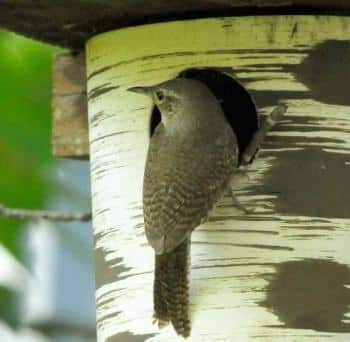The Two Faces of House Wrens

House Wren
Photo credit: Jim Williams
by Val Cunningham
Contributing Writer
These tiny, energetic birds are a backyard favorite but it’s not surprising that bluebirds and chickadees consider them home wreckers.
Birds are singing from pre-dawn to post-dusk in a heady mixture of trills, chirps, whistles and buzzes. Our inner ears are primed for our favorite birds: “Oh, there’s an oriole,” or “Hey, that’s the indigo bunting!”
One fine day, usually around mid-May, a distinctive bubbly song announces that house wrens are back. Many people rejoice at the return of these small (under 5-in. long), active birds with their turned-up tails. I have to admit to mixed feelings about house wrens, but more about that later.
House wrens are little dynamos, hopping quickly through shrubs and vines, and, in woodlands, across toppled trees and branches. They’re very tolerant of humans and will nest in just about anywhere with the right overgrown habitat. For many people, this is their favorite bird: they like the wren’s confiding nature, jaunty cocked tail and loud, burbling song.
In fact, a friend advises anyone who puts up a wren house to make sure they like that distinctive song, “because you’re going to hear it all day long.”
Wrens don’t visit feeders, instead hunting spiders and insects such as beetles, bugs and various caterpillars. They stuff their nestlings with a similar diet, along with grasshoppers and crickets.
Real estate hogs
When it comes time to nest they search out tree holes, or crevasses in stone piles, even hollow logs. They ready use of nest boxes endears them to many people. Indeed, if you hang several nest boxes, a male wren will usually usurp every one. Males prepare a number of starter nests for a female’s consideration, stuffing all available cavities with 3- and 4-in. twigs. She does an inspection tour, then chooses a single cavity and finishes the nest herself.
The sticks aren’t the true nest, but form a platform for holding a small cup nest deep inside. This construction keeps the nestlings above rainwater or other seepage.
A finished nest might rest on hundreds of twigs, but consider the industrious wren who commandeered a wood duck box on a friend’s property—this large structure was stuffed to the roof with twigs— thousands and thousands of twigs. Wrens are also known to nest in old boots and shoes, flower pots and items left on out a clothesline.
Their dark side
Wrens covet all nest sites on their territory, and can become fierce pillagers of other birds’ nests. This is where they run afoul of some humans. A wren will enter a nest box already in use by another species and peck open the eggs by or will toss out nestlings. They’re notorious for ruining the nests of chickadees, bluebirds and tree swallows and even, at times, killing the adult birds. Wrens will even peck open eggs of birds that nest out in the open, like robins and cardinals, even though they have no use for the nest site.
This is the side of wrens that I don’t like, and explains why their exuberant song can sound both joyful and threatening. However, their behavior is part of the natural order of things, and serves to maximize their population. It’s incumbent on those of us who want to host bluebirds and chickadees to keep nest boxes away from woody areas, to discourage these small, fierce birds.
After nesting season wrens become secretive and silent, and many of us won’t even notice when they leave in September, heading for the southern United States or Mexico.
St. Paul, Minnesota resident Val Cunningham, leads bird hikes for the St. Paul Audubon Society and writes about nature for local, regional and national newspapers and magazines.



